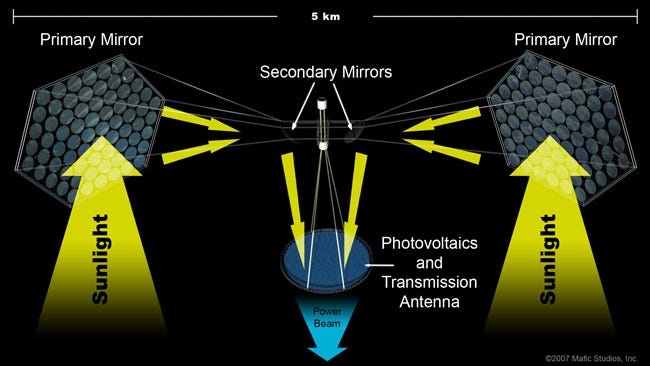# Exploring Solar Power in Space: A Path to Sustainable Energy
Written on
Chapter 1: The Emergence of Solar Energy
As I traverse through various neighborhoods, the presence of solar panels on rooftops has become increasingly noticeable. It's not just a trend among homeowners; businesses, non-profits, and local governments are also investing heavily in solar energy. To generate a gigawatt-hour of electricity yearly, roughly 3.4 acres of solar panels are required. Scaling this up, the U.S. would need an astounding 13.6 million acres (or about 21,250 square miles) of solar panels to meet its annual energy demands. Surprisingly, this constitutes only about half a percent of the country's land area, which is roughly equivalent to the land currently leased for oil and gas extraction.

While expanding rooftop solar installations could reduce the land required, the primary challenge lies not in space but in the political and economic will to push solar initiatives forward. Our current reliance on fossil fuels may be holding us back from effectively harnessing solar power. However, a shift towards space-based solar power could offer a groundbreaking solution.
Section 1.1: Understanding Photovoltaic Technology
Photovoltaic (PV) panels function as semiconductors, generating electrons when sunlight excites their materials. These panels can power everything from small devices like traffic signs to larger systems on rooftops or solar farms. Although traditional silicon solar cells are not 100% efficient, the inefficiencies of other energy sources, like internal combustion engines, are often overlooked. With the cost of solar materials and installation decreasing, we can expect continued growth in solar projects, even amid the complexities introduced by tariffs and market fluctuations.
The first video titled "Why Should We Launch Solar Panels Into Space?" discusses the potential advantages of deploying solar panels in orbit, providing insights into how this approach could enhance energy generation.
Section 1.2: The Case for Solar Power in Space
The sun offers abundant energy that could feasibly meet global energy needs, especially as we transition to electric transport and improve battery storage technologies. However, terrestrial solar power faces significant challenges. Space-based solar power (SBSP) could circumvent these obstacles by capturing sunlight without atmospheric interference.
Historically, solar panels have powered various spacecraft, including the International Space Station (ISS), which has been operational for over two decades. The ISS's solar arrays generate more electricity than the station requires, storing the excess for use during periods without sunlight. In total, the ISS's solar panels cover about 27,000 square feet and can produce between 84 to 120 kilowatts of electricity—enough to power over 40 homes.
Chapter 2: Innovations in Space-Based Solar Power
The second video, "How space-based solar power can save the planet," explores the innovative potential of SBSP and its implications for sustainable energy on Earth.
Our atmosphere, while protective, limits the efficiency of solar energy generation. SBSP aims to overcome these limitations by capturing sunlight in space and transmitting it back to Earth. Large arrays and platforms could be launched into orbit, utilizing mirrors to focus solar energy onto collectors. This energy would then be beamed down to power stations on Earth.
Self-assembling satellites equipped with energy transmitters could revolutionize energy collection and distribution. As technology continues to evolve, the feasibility of SBSP is becoming more viable. Countries like China and Japan are actively pursuing these advancements, potentially igniting a new space race focused on sustainable energy.

While SBSP presents numerous advantages, including consistent energy delivery, the costs associated with its development must be addressed. However, these costs are diminishing compared to the ongoing expenses of fossil fuel extraction and the broader implications of climate inaction. As we confront the urgent need for solutions to climate change, SBSP may represent a promising pathway forward.